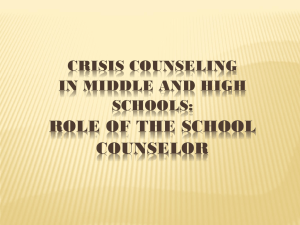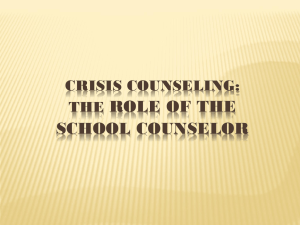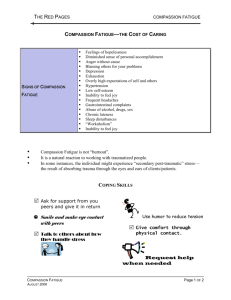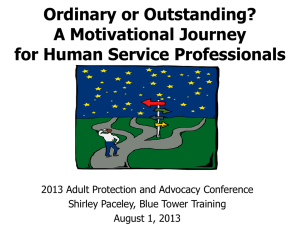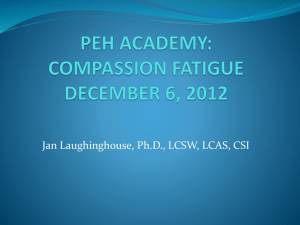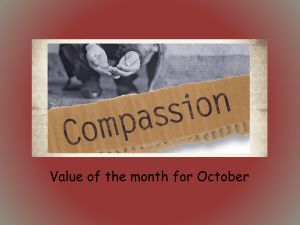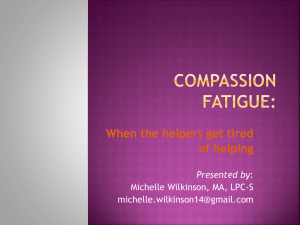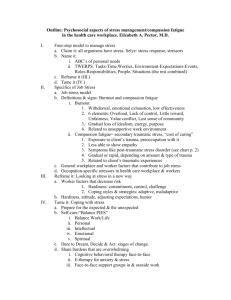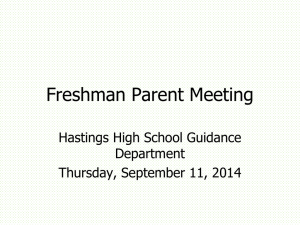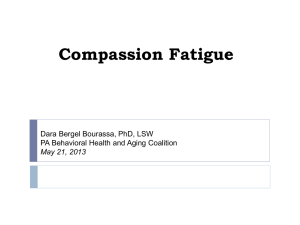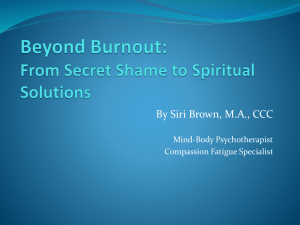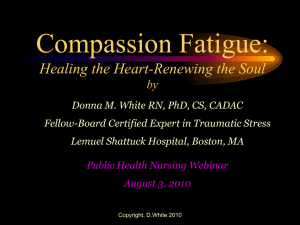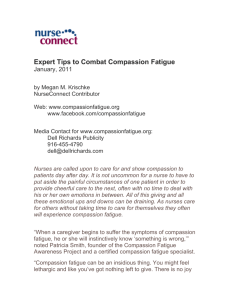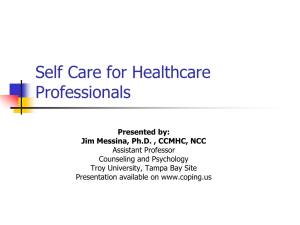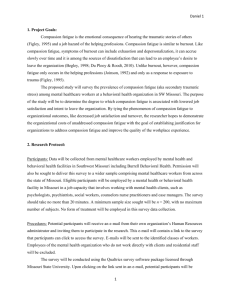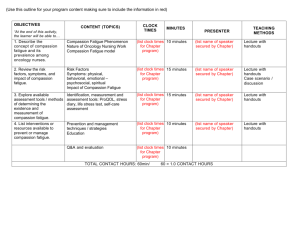Powerpoint - Guidance Expo
advertisement
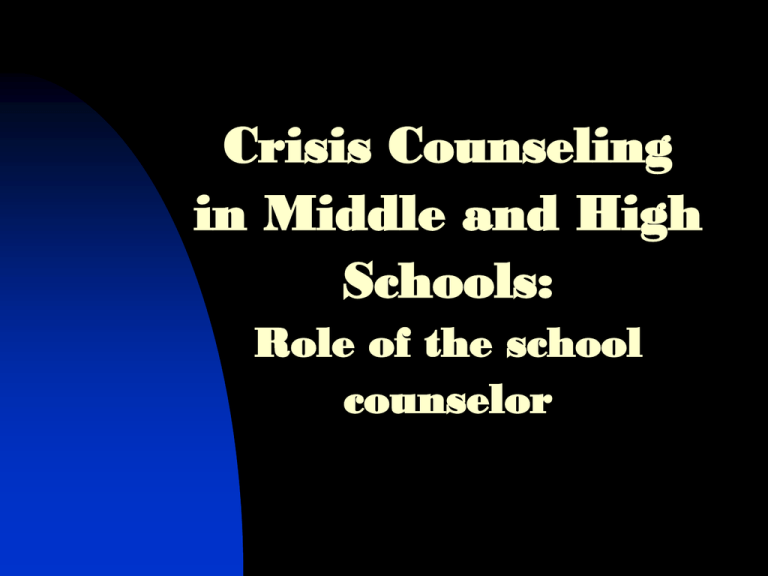
Crisis Counseling in Middle and High Schools: Role of the school counselor Presenters Professor Robert Stevenson, Ed.D. Professor Arthur McCann, Ph.D. Mercy College School of Behavioral and Social Sciences Graduate Counseling Programs Presentation Objectives Define a crisis (personal vs. group) Clarify definitions of terms Lifecycle of a crisis Identifying the counselor’s role in assisting: Students Faculty Administration Community Ourselves What is a Crisis? PERSONAL – A perception or experiencing of an event or situation as an intolerable difficulty that exceeds the person’s current resources and coping mechanisms. GROUP – A situation that holds the potential for either disaster or opportunity. Reaction to Personal Crisis Individuals in crisis can: Cope by themselves and grow stronger from the experience Survive the immediate crisis, but block it from consciousness leading to future problems Break down from the crisis – putting life on hold unless they receive immediate assistance Crisis Management Life Cycle Prepare Mitigate Respond Recover Crisis Characteristics Every crisis is complicated The disequilibrium of crisis provides impetus for change (+/-) Brief therapy can help – but it treats the symptoms, not the cause Choice is essential Crisis is “universal” because no one is immune. Crisis is time limited (6-8 weeks). Operational Definitions CRISIS – a serious or decisive state where an action will have positive or negative consequences. CRISIS COUNSELING – a process that has as its focus the emotional ramifications of a crisis. CRISIS INTERVENTION – steps to address the immediate problem using a variety of resources. CRISIS PREVENTION – a process for reducing acute, emotional upset. This may involve examination of coping behaviors, resources and developing assessment skills. CRISIS PREPARATION – A plan of development and training that develops positive attitudes and skills among all members of a school community. CRISIS POSTVENTION – process for “damage” assessment and recovery. Planning for Crisis Management Ask the right questions (what, where, when, how and, in some cases, why) Identify precipitating events Establish goals and operational definitions Create a crisis response plan with clearly identified steps Create and implement response protocols Begin ongoing evaluation and mitigation Assigning “Meaning” It is important for a counselor to understand the meaning a person assigns to an event or an emotion. These can be seen as any of the following: • A Challenge – to be overcome • • • • A Loss – making change difficult or impossible A Gain – a sign that one is working to maximum ability A Punishment – penance for not doing something right (or for doing something wrong) in the past A Reality – to be assessed and dealt with so that it can be reduced to an acceptable level Assessment Triage Affect: Behavior: Anger/Hostility Fear/Anxiety Sadness/Melancholy Approach Avoidance Immobility Cognition: Transgression (present) Threat (future) Loss (past) Crisis Intervention Models The chosen model needs to assess and address: Equilibrium – disequilibrium creates a need to regain stability Cognition – faulty thinking may need to be changed Psychosocial Transition – internal and social change may create a need for new internal coping mechanisms that are adequate to the demands of the crisis Six Step Model of Crisis Intervention Assessing (throughout counseling) Listening 1. Define the problem 2. Ensure client safety 3. Provide support Acting 4. Examine alternatives 5. Make plans 6. Obtain Commitment Assessment “A–B–C” Affect – abnormal or impaired affect is a sign of disequilibrium Behavior – immobility impairs behavior so doing something concrete helps forward movement Cognitive state – has the crisis been made worse by rationalizing, exaggerating or faulty belief(s) LISTEN for: Open-ended questions Closed-ended questions Owning feelings Disowned statements Conveying understanding Value judgments Positive reinforcement Empathy, genuineness, acceptance Taking Action: See individual differences Assess yourself Acknowledge client safety Provide client support Define the problem Consider alternatives Plan action steps Use client coping strengths Attend to client’s immediate needs Use referrals (when appropriate) Develop and use networks Get a commitment The Counselor’s Role: Listen to concerns Assess safety needs Make owning and assertive statements about the your role Deal with current client functioning concretely and objectively Speak clearly, in the present, about the problem Take immediate, direct action to restore mobility and equilibrium School Counselor Interventions with Grieving Students Be proactive in providing help. Encourage student to get help from family and friends. Encourage self-care ( exercise, rest and healthy diet.) Listen without judging. Encourage talking about loss, while being mindful of the stages of grief (denial or shock, fear, anger, guilt, depression or sadness, and acceptance.) Invite sharing of memories. Encourage talking about loss. Invite sharing of memories. Encourage resumption of normal activities. (Source: List 7.18 Dealing with Grief and Loss in The School Counselor’s Book of Lists, second edition) The School Counselor’s Role in Helping Teachers When a Student Dies When speaking with bereaved parents, be supportive, only give suggestions when requested, ask what they would like shared with other students. Offer to visit class to tell students what happened. Prepare the teacher (or offer to collaborate) regarding how to tell classmates. Match information with the students’ developmental ability to understand. Give the message that life is precious and precarious. If death is by suicide, do not glorify and do not try to explain why. Be truthful, honest and accepting. Coordinate follow up steps with teacher and administrator. Inform the faculty in the may the parents or guardians desire. Pay special attention to siblings and special friends. (Source: List 7.20 Dealing with Grief and Loss in The School Counselor’s Book of Lists, second edition) Surviving and Moving On Help the student to: Accept the loss(es). Be aware of feelings Externalize emotions. Draw on personal beliefs. Understand negative coping Utilize every resource (because there is seldom one correct answer to most of the questions that arise) Preventing “Compassion Fatigue” Compassion - A “feeling of deep sympathy and sorrow for another who is stricken by suffering or misfortune, accompanied by a strong desire to alleviate the pain or remove its cause.” (Webster’s, 1989, p.229). Compassion Fatigue - (aka, secondary traumatic stress, nearly identical to PTSD, vicarious traumatization) - This is similar to emotional contagion, “…defined as an affective process in which an individual observing another person experiences emotional responses parallel to that person’s actual or anticipated emotions.” ( Figley, 2002) Compassion Satisfaction – Stamm (2002) has identified this as a protective factor, a positive side of compassion that counterbalances the negative. She developed a Compassion Satisfaction and Fatigue (CSF)Test to help estimate risk of burn out and compassion fatigue. Preventing “Compassion Fatigue” cont’d Develop our capacity for humor. Gain a sense of achievement and satisfaction from setting achievable work standards. Acquire adequate rest and relaxation. Develop and regularly incorporate an array of stress reduction methods into our repertoire. Let go of work. Apply Critical incident stress debriefings and stress management (CISD/M ) plans and actions as needed when crises arise. (Source: Treating Compassion Fatigue edited by Charles R. Figley, 2002) Empowering Objects AMULET – an object (such as a horseshoe) that wards off evil. TALISMAN- an object that enables the one who possesses it to accomplish great deeds. In some cases, one object may serve as both amulet and talisman. Filling Your Bag of Tricks Explaining “change” A Lens Overcoming obstacles Levitation Dealing with feelings Bulletin Board / Tennis Coping with stress A Worry Stone Creating a Safe Place Ernie, Bert & Theodore Overcoming Helplessness Candy Bear Words as Talisman Quotation Posters Giving form to fear and coping How Big Is Your Dragon? Resources Blum, D.J. and Davis, T.E. (2010). The School Counselor’s Book of Lists, 2nd edition, San Francisco, CA: Jossey-Bass. Federal Emergency Management Agency (FEMA) http://training.fema.gov/IS/ Figley, C.R., ed. (2002). Treating Compassion Fatigue, New York , NY: Brunner-Routledge. James, R. K. and Gilliland, B. K. (2004). Crisis Intervention Strategies 5th edition, Brooks/Cole. Stevenson, R. G., ed. (2002).What will we do? Preparing the school community to cope with crises, 2nd edition, Baywood Publishing. Stevenson, R.G. and Cox, G. ed. (2007). Perspectives on Violence and Violent Death Amityville, NY: Baywood Publishing.
